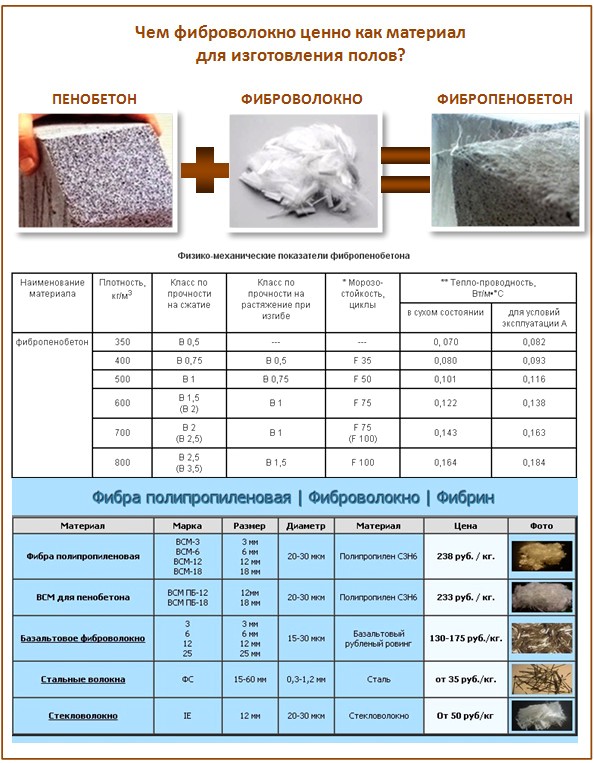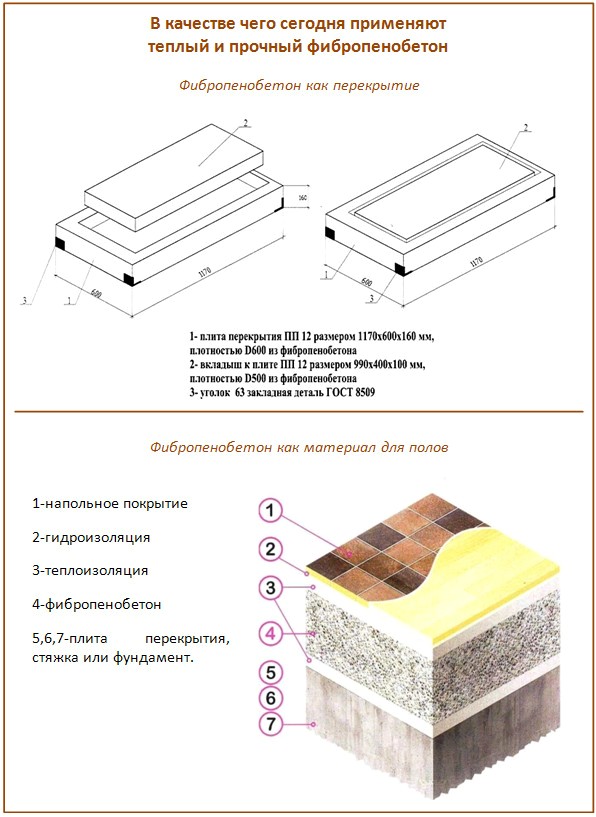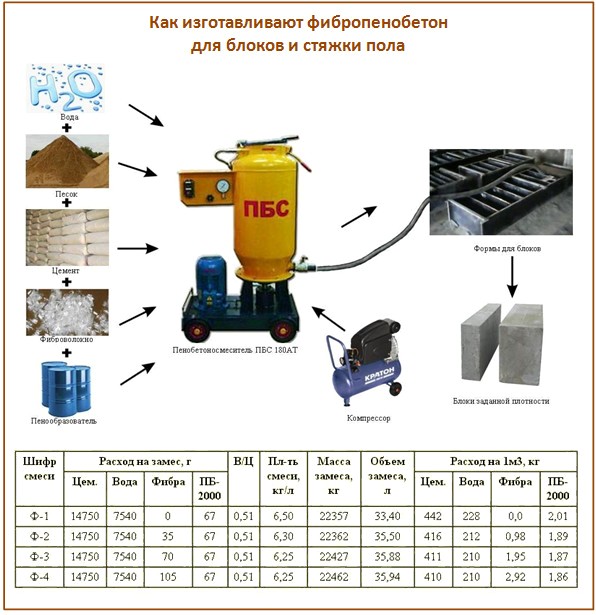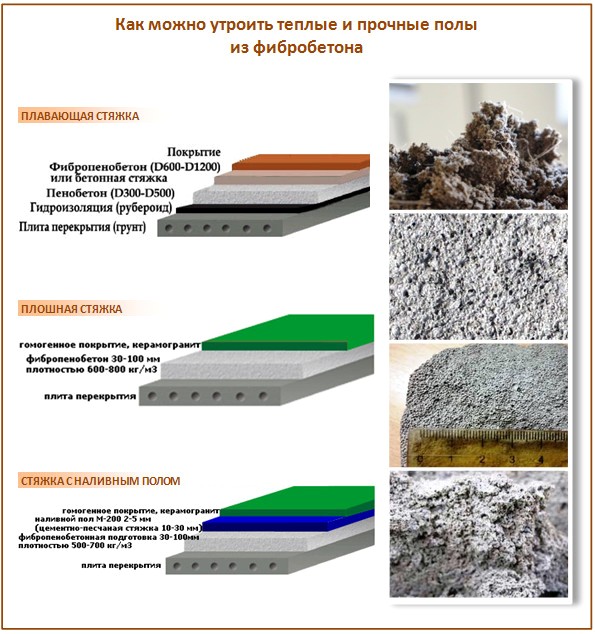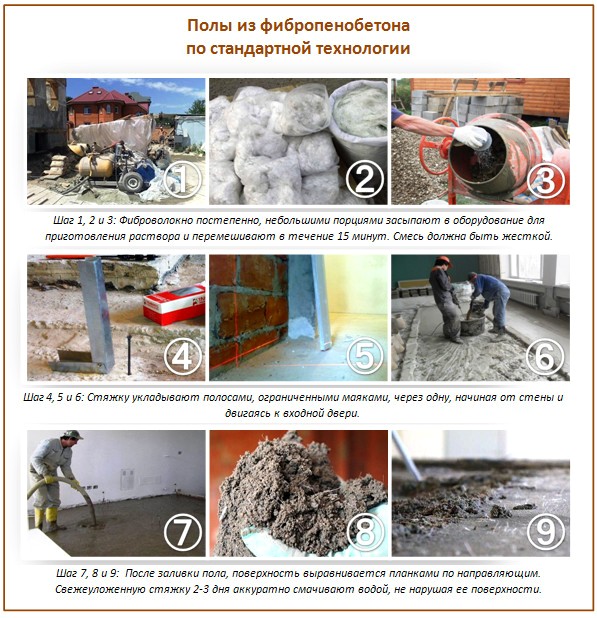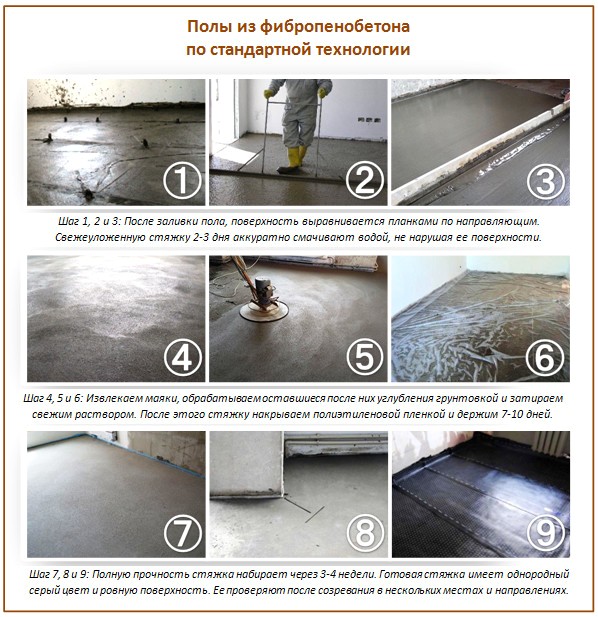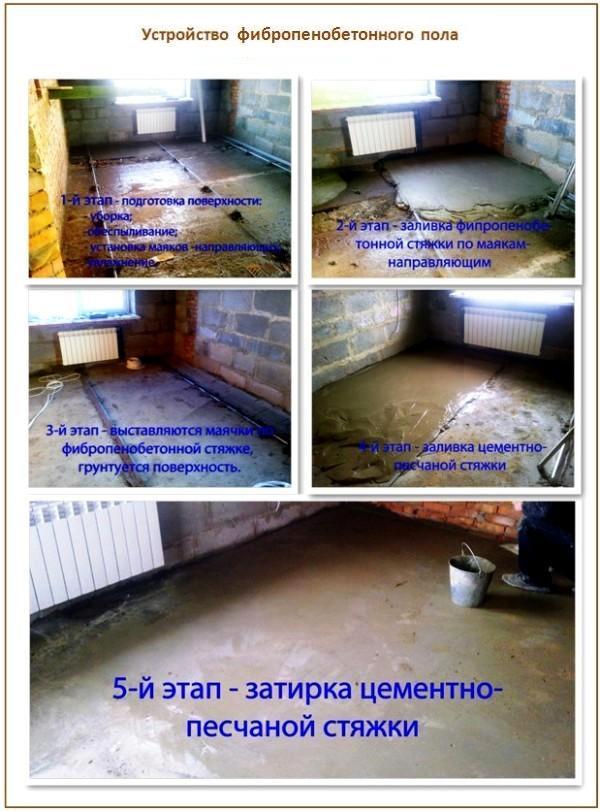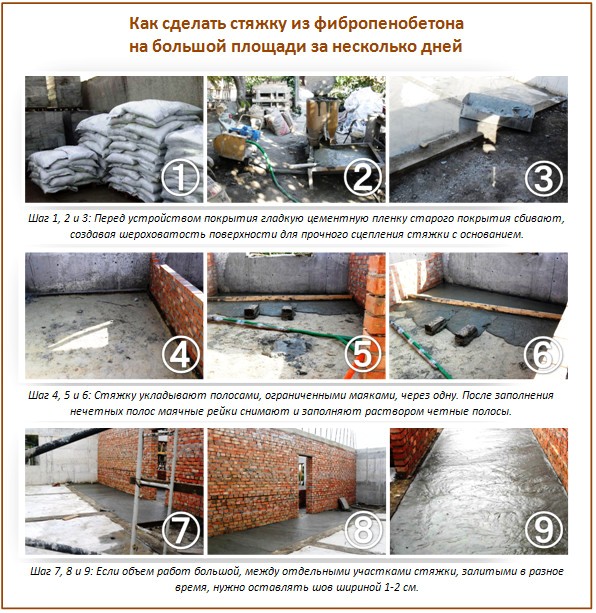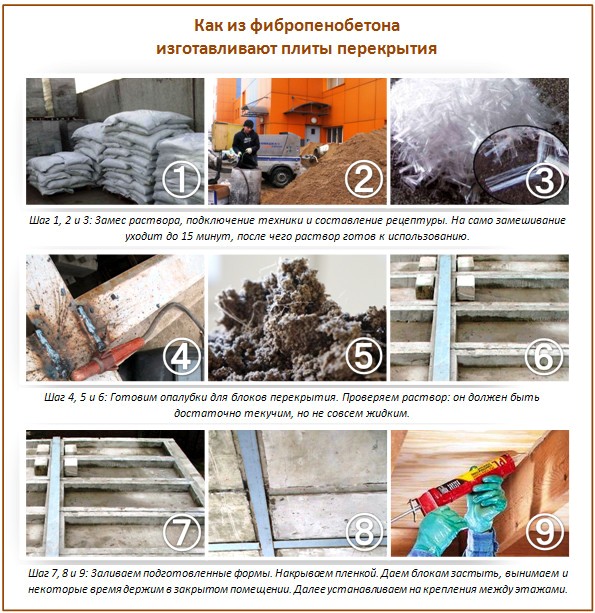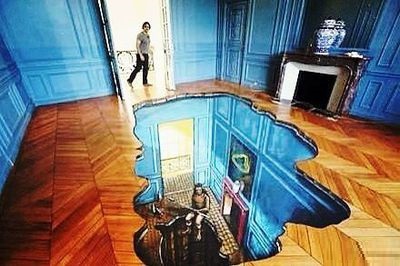Fiber-concrete floors: a review of the building composition + building rules
If you are a builder, then you probably often encountered problems that are usually associated with cement mortars. Dust, instability during frost, various shrinkage and subsidence, poor thawing, abrasion and cracks, cracks, cracks. It is almost impossible to do without it, which is why in everything, wherever possible, the majority tries to replace the cement mortar with some analogue: dry screed, wooden walls, unusual construction. But lately, a new mixture has become more and more popular - concrete and fiber.
First of all, we recommend that you watch a video about this wonderful building material:
Content
What is fiber concrete?
This discovery occurred thanks to a series of studies of concrete mixtures. And it turned out that the foam concrete, to which fiber is added in the manufacture, becomes an excellent material: it is warmer and lighter than wood, but at the same time it is harder and much stronger. And it turned out that the floors from such a screed are especially warm and durable, almost never crack and are remarkably processed. We can say that you can finally forget about all those problems that used to be so annoying when working with an ordinary concrete screed.
In fact, fiber is a fiber made of polypropylene, which is designed to reinforce concrete and mortar from cement and gypsum. Any screed from such an additive acquires the necessary ductility and good resistance to stretching and impact. And also - stability and uniformity are much better than with conventional mixtures.
Not a single chemical additive can boast of what fiber fiber does for floor screed - it creates three-dimensional volume reinforcement for it. Fiber fiber in foam concrete allows it to crystallize cement stone in a directional way, without lumps, firmly and non-shrinking. The entire structure of foam concrete is optimized, and the risk of internal defects is significantly reduced.
For floors, fiber works as a cheaper, but no less high-quality replacement for steel reinforcing mesh, and when laying concrete - already as an additional reinforcing element. Due to the presence of fiber in the screed, the floors shrink without cracks, and as a result turn out to be much more durable and shockproof. There are studies confirming that the use of fiber:
- reduces up to 90% defective products;
- 60% increase the resistance of the floor to abrasion;
- 5 times - to cracking;
- increases frost resistance;
- 35% waterproof;
- up to 70% - bending strength under compression;
- Up to 35% - impact resistance;
- Up to 90% - the destruction of concrete, no chips, no fragments.
The fiber acts as follows: during a critical period of 2-6 hours after laying the floor, this reinforcing element increases the ability of the solution to deform without destruction, and after the final hardening during the shrinkage of the fiber, the edges of possible cracks are connected, and the risk of breakage is already much lower. Less such floor will also produce water, which means a valuable reduction in internal load.
For comparison: fiber in any concrete solution eliminates the formation of shrinkage cracks by 60-90%, while the reinforcing mesh - only 6%.Moreover - fiber is absolutely resistant to all chemical additives that are already in concrete. It has excellent heat resistance, no corrosion and no need for high-speed mixers.
The minimum dose of fiber in fiber-reinforced concrete is 600 g / m3. A dosage of 900 g / m3 allows to increase the strength of the screed by as much as 25% and reduce the amount of cement to 7%.
Use fiberglass 12 mm long for the manufacture of floors - this is what builders recommend. But the fibers of 18 m and 6 mm long are designed completely for other types of construction. The Propex fiber is considered to be the best quality today - it does not form lumps, allows you to sand floors well and reduces the risk of cracking during shrinkage by up to 90%.
What is the advantage of fiber-reinforced concrete floors?
So, why are newfangled fiber concrete floors so good? See for yourself:
- Porous structure. And this is a wonderful sound and heat insulation, which is just what is most valuable for floors.
- Perfectly flat surface. In fiber-reinforced concrete, due to the presence of fiber reinforcement, there are no lumps, and after full shrinkage, the floors are perfectly smooth.
- Easy styling, even by professional hands.
Due to the special fluidity of this material, they can fill any void spaces, even in the most inaccessible places - window sills, pipes. A vibratory seal is not needed for such a floor, as there is almost no shrinkage as such. And most valuable is fiber-reinforced concrete for its characteristics of load distribution.
Also, fiberglass floors have high fire resistance. Even when exposed to a blowtorch, such a screed will not split and will not explode, as heavy concrete can do. In addition, not so long ago, an interesting experiment was carried out in Australia: a wall of foam concrete with a thickness of only 15 cm was heated to 12000 ° C, but even after as many as 5 hours of testing it barely reached 460 ° C. And then the material did not emit any harmful substances during heating, but we are forced to cover ordinary concrete structures with basalt wool and plastic for insulation, which is literally fatal in case of a fire.
Even in severe frosts and in an unheated room, the surface of such a floor will have 2-5 ° С - all thanks to the thermal conductivity of concrete, which is 2.5 times less than that of a conventional concrete screed. And the lower this indicator, the warmer the floor will be.
In fact, a fiber-reinforced concrete screed is similar in its properties to a light and durable artificial stone.
How to make fiber concrete at home?
Here is how you can make fiber concrete for filling floors, if you have the necessary equipment - there are two ways to add fiber fiber:
- Method 1. We fall asleep in a construction mixer, in a dry mixture without water - this way the fiber is distributed better. Just while mixing, add the fiber in parts.
- Method 2. Add directly to the batch.
So, the first way:
Step 1. Connect the equipment. Check the direction of rotation - should be counterclockwise.
Step 2. Fill the water (calculate in advance, starting from the water absorption of the sand used) and start.
Step 3. During the operation of the equipment, load the following components:
- Cement.
- Sand.
- Frother 150-300 g.
- Fiber fiber 30-50 g.
And tightly close the hatch. Immediately press the "Stop" button and then the "Start" button, and count the time by the timer.
Step 4. We collect 1.8 ATM pressure on the pressure gauge and close the air supply valve.
Step 5. We wait for the end of the batch for about 3 minutes, and fill the floors.
The second way:
- Step 1. Pour sand into the mixer, than immediately knit water from the previous mixture.
- Step 2. Now - cement, and mix everything thoroughly until the mixture becomes a uniform color. This is a crucial stage.
- Step 3. We close the mixture with water according to the selected recipe. Mix everything again until a homogeneous plastic mass is obtained.
- Step 4Add fiber, exactly 0.1% by weight of foam concrete. By the way, you can change the dosage depending on the desired final quality. With stirring, the fiber is itself distributed throughout the mixture.
What are the advantages of such an additive: fiber does not need to be fluffed in advance or mixed with water. But to combine with other additives is easy.
How to make a screed from fiber concrete?
There are standards for the manufacture of such floors. So, these are the requirements of GOST 25485 - 89 "Cellular concrete" and GOST 13.015.0 - 83.
Fiber-concrete for filling the floor is made quickly and easily. That is why today construction crews take for such floors only about 2500 rubles / m3. In addition, such technology also does not need additional labor or sophisticated equipment - everything is much simpler.
It is necessary to fill the floors with a special mobile unit with a productivity of 2-6 m3/hour. Hoses should be up to 30 m vertically and up to 60 m horizontally - so that the solution does not get stuck anywhere.
As an additional protection against cracking, you can use beacons made of waterproof plywood. Put them in increments of 1-2 meters. After pouring, you can safely leave right in the floor - so they will play the role of damping seams.
Now it is important to create the correct temperature and humidity conditions for the screed, namely, cover the concrete with plastic wrap. In a week, at a temperature of 22 ° C, foam concrete will gain up to 70% of brand strength.
As a result, a homogeneous monolithic layer is obtained on the overlap surface, which easily conceals all irregularities, quite warm and environmentally friendly.According to experienced builders, it is possible to walk on fiber-reinforced concrete floors on the fourth day, and such a foundation gains full strength in 28 days.
Here is an example of how such a floor is arranged on an uneven basis:
By the way, the combined option is considered to be the most effective when fiber-reinforced concrete with a density of 300-500 kg / m is used for the lower thermal insulation layer3, and as the top - with parameters of 600-1200 kg / m3. But for the reconstruction of buildings using fiber concrete with a density of 800 kg / m3due to which the floors in the apartments are warm and even.
And for greater insulation they are still poured like this:
Fiber-concrete as a finishing screed for floors is also good because it is light enough and does not create additional load. You will also be pleased with the fact that such a screed does not give any dust formation, and it is very convenient to work with it.
How to fill the screed on the foundation?
Here everything, as usual - formwork, ditch, pouring. And the screed device itself is quite simple. The day after pouring, smooth the floor with special equipment, and after grouting, maintain humidity for a week. To do this, moisten the screed three times a day and cover with plastic wrap.
And if you make a cement-sand screed on top of fiber-reinforced concrete, such a floor will have especially high strength characteristics.
And over the years, fiber-reinforced concrete floors only improve their strength and thermal insulation properties - all because of the long internal maturation. Therefore, you do not have to worry about the strength of such a foundation.
Fiber-concrete slabs
Fiber-concrete is made as separate floor slabs, as well as sound and heat insulation for them. Moreover, the plates are very strong due to the additional reinforcement, but at the same time, light. That for any building is a big advantage.
And such floor slabs also have a number of significant advantages:
- Do not accumulate moisture.
- Do not contain any hazardous substances.
- Do not caking.
- Their service life is not limited.
- Not damaged by rodents and insects.
- Not susceptible to mold or mildew.
A clear advantage of such construction is also that there is no heap of huge slabs or bulk materials at the construction site, and all this does not need to be constantly moved somewhere.And to insulate such plates for a private house is recommended in the following sequence: waterproofing, primer, screed, topcoat.
Therefore, we assure you: the floors made of fiber-reinforced concrete are warm, light and durable. It is not without reason that in the construction world today they claim that the future is behind this material.

